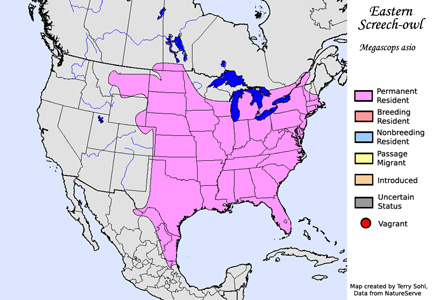CLICK ON THIS LINK TO WATCH AND LISTEN TO THE CALL OF THE EASTERN
SCREECH OWL
https://www.earthtouchnews.com/natural-world/animal-behaviour/screech-owls-keep-blind-snakes-as-live-in-housekeepers
Screech owls keep blind snakes as live-in housekeepers
Screech owls keep blind snakes as live-in housekeepers
BY DAVID MOSCATO FEBRUARY 27 2017
An owl inviting a snake to live in the nest with its babies may sound like the plot of a kids' movie, but nature is full of unlikely partnerships, and in Texas, screech owls do have a habit of bringing tiny blind snakes home with them.
Eastern screech owls can be found all over eastern North America. They're known for their small size – they're only 15-25cm (6-10 inches) tall – and for their noisy cries. But like all owls, they're expert hunters, flying on silent wings and snatching up prey under the cover of darkness.
During nesting season, the birds don't just hunt for themselves. When they capture prey, they kill it – often removing its head, you know, just to be sure – and bring it back to the tree hole where hungry owlets are waiting. But one animal seems to be safe from the screech owls' talons: the Texas blind snake. These captives are brought back to the nest alive.
This unusual behaviour was noticed by researchers back in the 1980s, while they were observing the owls hunting. "Reptilian prey often dangles from the bill of adult screech owls upon delivery to a nest, but … live blind snakes were coiled about the bills of the owls that carried them," they note in their study.
Texas blind snakes (or thread snakes) could easily be mistaken for worms. They're typically less than 30cm (12 inches) long and spend most of their time burrowing through soil. Despite their name, they aren't completely blind, but it's pretty close – the snakes use their tongues and noses to track down tiny bugs, which they vacuum up with their bizarre forward-and-backward swinging jaws.
Puzzled by the owls' snake-sparing behaviour, the scientists studied their nests for a period of time. They found that while some of the blind snakes did get eaten by the owl chicks, most ended up burrowing into the debris at the bottom of the nest, where they would continue to live for days, out of sight – and beak – of the birds.
But there was more. Close inspection revealed that nests with snakes in them had far fewer bugs. It turns out the reptilian roomies weren't just surviving in their new digs – they were also finding food: critters like ants, termites or larvae, some of which likely hitchhiked in from the outside world on the momma owl.
So was the presence of the snakes good for the growing chicks, the researchers wondered? It seemed possible that the reptiles were gobbling up potentially pesky bugs that might otherwise become parasites to the growing chicks, or contaminate their food.
Range of the Eastern Screech Owl

For several weeks they watched, weighed and assessed the nestlings. In the end, they found that baby birds living with blind snake roommates tended to grow faster and had better chances of survival. The snakes being brought to the nest alive wasn't simply an accident – they were acting as tiny, unwitting parenting aides!
Range of the Eastern Screech Owl

For several weeks they watched, weighed and assessed the nestlings. In the end, they found that baby birds living with blind snake roommates tended to grow faster and had better chances of survival. The snakes being brought to the nest alive wasn't simply an accident – they were acting as tiny, unwitting parenting aides!
This is a remarkable case of symbiosis – a partnership between species. Some have called it mutualism, which describes a situation where two species benefit each other, but given the fact that the snakes are still sometimes eaten by the owlets (and don't survive well once the nest is vacated), this might really by acommensal relationship, where one species reaps a benefit and the other does its best to deal with the situation.












No comments:
Post a Comment